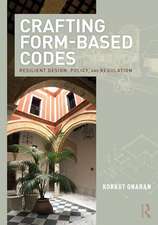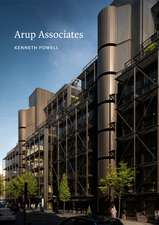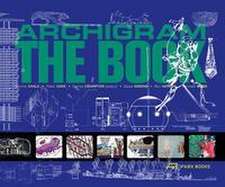Behind Architectural Filters: Phenomena of Interference
Autor Miguel Guitarten Limba Engleză Paperback – 25 mar 2022
This book explores architectural filters as connecting mechanisms capable of conjuring unique atmospheres that integrate the participation of several agents. The text analyzes ten case studies, grouped under five generative parameters: origin, density, thickness, function, and message. Each study investigates the main aspects of the filters’ internal genesis and the character of the spaces informed by them. The cases illustrate a broad geographic, cultural, and historical scope, and connect past tradition with contemporary design. This methodology considers a historical and philosophical standpoint addressing vernacular, constructive, sustainable, and sensory considerations.
Written for students and scholars of architectural history, theory, art, design, and philosophy, Behind Architectural Filters: Phenomena of Interference offers an unprecedented perspective on the production of spatial atmospheres, bridging past and present while connecting thought and practice in a highly visual study.
Chapter 3 of this book is available for free in PDF format as Open Access from the individual product page at www.routledge.com. It has been made available under a Creative Commons Attribution-Non Commercial-No Derivatives 4.0 license.
Preț: 292.89 lei
Nou
Puncte Express: 439
Preț estimativ în valută:
56.05€ • 58.19$ • 46.74£
56.05€ • 58.19$ • 46.74£
Carte disponibilă
Livrare economică 03-17 martie
Livrare express 14-20 februarie pentru 47.51 lei
Preluare comenzi: 021 569.72.76
Specificații
ISBN-13: 9781032077499
ISBN-10: 1032077492
Pagini: 302
Ilustrații: 220 Halftones, black and white; 220 Illustrations, black and white
Dimensiuni: 178 x 254 x 17 mm
Greutate: 0.84 kg
Ediția:1
Editura: Taylor & Francis
Colecția Routledge
Locul publicării:Oxford, United Kingdom
ISBN-10: 1032077492
Pagini: 302
Ilustrații: 220 Halftones, black and white; 220 Illustrations, black and white
Dimensiuni: 178 x 254 x 17 mm
Greutate: 0.84 kg
Ediția:1
Editura: Taylor & Francis
Colecția Routledge
Locul publicării:Oxford, United Kingdom
Public țintă
Postgraduate and Undergraduate AdvancedCuprins
Contents
Foreword. Harmonic Interference
David Leatherbarrow
Heilige Familie Church. Oberhausen, Germany. Rudolf Schwarz. 1956
Figure Filters
Nôtre Dame du Haut. Ronchamp, France. Le Corbusier. 1955
6. Conclusions: Behind Architectural Filters
Index
Acknowledgements
Biography
Foreword. Harmonic Interference
David Leatherbarrow
- Introduction. Materializing Light and Gaze
- The Filter as a Limit of SpaceApproaching the Idea of the Limit
Transforming Matter
Contour Conditions
On the Geometry of Filters
From Tradition to Virtuality: Historiographic Categories
The Dissipated Space Behind the Filter - The Filter as a Transitional SpaceA Place of Lights and Shadows
The Vision of the Horizon
Exterior and Interior Landscapes
The Transitional Space: Ma and Engawa - The Filter as Structure and ConstructionNatural Structure and Artificial Structure
The Structure of the Filter: Operations of Subtraction and Addition
The Stereotomic Filter: Predominance of Matter Over Air
The Tectonic Filter: Predominance of Air Over Matter
From the Perforated Box to the Disaggregated Framework - Generative Strategies
- Strategies of Origin. Earth Filters and Air Filters
Earth Filters
Royal Bath. Comares Palace. The Alhambra. Granada, Spain. Fourteenth Century
Air Filters
Recoletos Court. Madrid, Spain. Eduardo Torroja; Secundino Zuazo. 1935 - Strategies of Density. Heavy Filters and Light Filters
Heavy Filters
Melnikov House. Moscow, Russia. Konstantin S. Melnikov. 1927
Light Filters
Shuster Hall. Hunter College. Bronx, New York, US. Marcel Breuer; Robert F. Gatje. 1959 - Strategies of Thickness. Shallow Filters and Deep Filters
Shallow Filters
Sarkhej Roza. Ahmedabad, India. Fifteenth Century
Deep Filters
Tower of Shadows. Chandigarh, India. Le Corbusier. 1956 - Strategies of Function. Structural Filters and Enclosing Filters
Structural Filters
Public Library. Seattle, WA. Rem Koolhaas; Joshua Prince-Ramus. 2004
Enclosing Filters
Dominus Winery. Napa Valley, CA. Herzog & De Meuron. 1998 - Strategies of Attention. Ground Filters and Figure Filters
- Strategies of Origin. Earth Filters and Air Filters
Earth Filters
Heilige Familie Church. Oberhausen, Germany. Rudolf Schwarz. 1956
Figure Filters
Nôtre Dame du Haut. Ronchamp, France. Le Corbusier. 1955
6. Conclusions: Behind Architectural Filters
Index
Acknowledgements
Biography
Recenzii
"A study of remarkable breath and introspection, Professor Guitart’s book Behind Architectural Filters: Phenomena of Interference delves into one of the most important constituents of architecture, the defining role of its enveloping borders as filters. Being the interface between the realm of architecture and what lies beyond, they significantly shape not merely the physical entity of a building but also its spatial articulation and atmosphere. Such filters are ‘instruments’ through which inner and outer worlds are connected and reconciled while guiding our perception toward a more nuanced understanding of both as well as ourselves within them. Covering a broad panorama of the centuries-old evolution and culturally articulated diversity of these mediating filters, the book focuses not as much upon their pragmatic and measurable dimensions as it highlights their immeasurable or phenomenological ramifications. In so doing, this scholarly study, along with outlining an ontology of architecture, also reflects on the related fundamental aspects of human existence. In our troubled world of today, a more intense and sensible relationship between architecture and its environment, especially the natural one, is of paramount importance. It is also in this regard that this book should be an indispensable addition to the library of every architect, as well as student and school of architecture." Botond Bognár, Professor and Edgar A. Tafel Endowed Chair in Architecture, School of Architecture, University of Illinois Urbana-Champaign, USA
"What is the nature of the envelope of a building? Architects and historians over the last 150 years have asked this question in countless ways supplying contradictory and fragmented answers. Should it shelter us or connect us to the world outside? Is it a skin, an environmental seal, or is it a space? Is it a fortress or a suit of clothes? If it is no longer structural, then what is it? Miguel Guitart has taken on the daunting task of examining these questions in depth putting constructional rigor, aesthetic ideology, and formal analysis to work analyzing key buildings of history and the modern era to produce a work that is profound and original, a means to understand the edges of a building not as a surface but as the essence of architecture." Edward Ford, Professor Emeritus, School of Architecture, University of Virginia, USA
"Buildings are usually seen as self-sufficient material objects. However, architecture mediates, articulates and intensifies our relations with the place and the world. This frequently unnoticed mediation takes place through geometry, scale, materiality, and illumination by various means of filtering experiences and interactions. Miguel Guitart’s intense study focuses on the perceptual, experiential, and emotional meanings of architectural filters in our relation with the world." Juhani Pallasmaa, Professor Emeritus, Aalto University, Helsinki, Finland
"Light is crucial in architecture, beyond its obvious practical uses, but we seldom meditate on how it operates. This important book is unique, for it provides a careful study with selected case studies of the mechanisms by which external light contributes to inner illuminations, to an architecture that may make life worth living, and to memorable architectural emotions." Alberto Pérez-Gómez, Professor Emeritus, McGill University, Montreal, Canada
"A study of remarkable breath and introspection, Professor Guitart’s book Behind Architectural Filters: Phenomena of Interference delves into one of the most important constituents of architecture, the defining role of its enveloping borders as filters. Being the interface between the realm of architecture and what lies beyond, they significantly shape not merely the physical entity of a building but also its spatial articulation and atmosphere. Such filters are ‘instruments’ through which inner and outer worlds are connected and reconciled while guiding our perception toward a more nuanced understanding of both as well as ourselves within them. Covering a broad panorama of the centuries-old evolution and culturally articulated diversity of these mediating filters, the book focuses not as much upon their pragmatic and measurable dimensions as it highlights their immeasurable or phenomenological ramifications. In so doing, this scholarly study, along with outlining an ontology of architecture, also reflects on the related fundamental aspects of human existence. In our troubled world of today, a more intense and sensible relationship between architecture and its environment, especially the natural one, is of paramount importance. It is also in this regard that this book should be an indispensable addition to the library of every architect, as well as student and school of architecture."
Botond Bognár, Professor and Edgar A. Tafel Endowed Chair in Architecture, School of Architecture, University of Illinois Urbana-Champaign, USA
"What is the nature of the envelope of a building? Architects and historians over the last 150 years have asked this question in countless ways supplying contradictory and fragmented answers. Should it shelter us or connect us to the world outside? Is it a skin, an environmental seal, or is it a space? Is it a fortress or a suit of clothes? If it is no longer structural, then what is it? Miguel Guitart has taken on the daunting task of examining these questions in depth putting constructional rigor, aesthetic ideology, and formal analysis to work analyzing key buildings of history and the modern era to produce a work that is profound and original, a means to understand the edges of a building not as a surface but as the essence of architecture."
Edward Ford, Professor Emeritus, School of Architecture, University of Virginia, USA
"Buildings are usually seen as self-sufficient material objects. However, architecture mediates, articulates and intensifies our relations with the place and the world. This frequently unnoticed mediation takes place through geometry, scale, materiality, and illumination by various means of filtering experiences and interactions. Miguel Guitart’s intense study focuses on the perceptual, experiential, and emotional meanings of architectural filters in our relation with the world."
Juhani Pallasmaa, Professor Emeritus, Aalto University, Helsinki, Finland
"Light is crucial in architecture, beyond its obvious practical uses, but we seldom meditate on how it operates. This important book is unique, for it provides a careful study with selected case studies of the mechanisms by which external light contributes to inner illuminations, to an architecture that may make life worth living, and to memorable architectural emotions."
Alberto Pérez-Gómez, Professor Emeritus, McGill University, Montreal, Canada
"A consequence of modern technological and ideological change, which led to the imposition of architecture’s ‘insulation’ paradigm, was the fall into disrepute of the filter: the added or inserted element reviled by some for altering the way pure forms are perceived. But the tradition of the filter transcends this conflictive relationship with modernity. In fact it enriched architecture of the past and enriches architecture of the present, and this is the starting point of a carefully produced, profusely illustrated work where the architect and teacher Guitart examines architectural filters as connecting mechanisms that conjure spatial atmospheres and generate physical and sensory experiences."
-Arquitectura Viva
"What is the nature of the envelope of a building? Architects and historians over the last 150 years have asked this question in countless ways supplying contradictory and fragmented answers. Should it shelter us or connect us to the world outside? Is it a skin, an environmental seal, or is it a space? Is it a fortress or a suit of clothes? If it is no longer structural, then what is it? Miguel Guitart has taken on the daunting task of examining these questions in depth putting constructional rigor, aesthetic ideology, and formal analysis to work analyzing key buildings of history and the modern era to produce a work that is profound and original, a means to understand the edges of a building not as a surface but as the essence of architecture." Edward Ford, Professor Emeritus, School of Architecture, University of Virginia, USA
"Buildings are usually seen as self-sufficient material objects. However, architecture mediates, articulates and intensifies our relations with the place and the world. This frequently unnoticed mediation takes place through geometry, scale, materiality, and illumination by various means of filtering experiences and interactions. Miguel Guitart’s intense study focuses on the perceptual, experiential, and emotional meanings of architectural filters in our relation with the world." Juhani Pallasmaa, Professor Emeritus, Aalto University, Helsinki, Finland
"Light is crucial in architecture, beyond its obvious practical uses, but we seldom meditate on how it operates. This important book is unique, for it provides a careful study with selected case studies of the mechanisms by which external light contributes to inner illuminations, to an architecture that may make life worth living, and to memorable architectural emotions." Alberto Pérez-Gómez, Professor Emeritus, McGill University, Montreal, Canada
"A study of remarkable breath and introspection, Professor Guitart’s book Behind Architectural Filters: Phenomena of Interference delves into one of the most important constituents of architecture, the defining role of its enveloping borders as filters. Being the interface between the realm of architecture and what lies beyond, they significantly shape not merely the physical entity of a building but also its spatial articulation and atmosphere. Such filters are ‘instruments’ through which inner and outer worlds are connected and reconciled while guiding our perception toward a more nuanced understanding of both as well as ourselves within them. Covering a broad panorama of the centuries-old evolution and culturally articulated diversity of these mediating filters, the book focuses not as much upon their pragmatic and measurable dimensions as it highlights their immeasurable or phenomenological ramifications. In so doing, this scholarly study, along with outlining an ontology of architecture, also reflects on the related fundamental aspects of human existence. In our troubled world of today, a more intense and sensible relationship between architecture and its environment, especially the natural one, is of paramount importance. It is also in this regard that this book should be an indispensable addition to the library of every architect, as well as student and school of architecture."
Botond Bognár, Professor and Edgar A. Tafel Endowed Chair in Architecture, School of Architecture, University of Illinois Urbana-Champaign, USA
"What is the nature of the envelope of a building? Architects and historians over the last 150 years have asked this question in countless ways supplying contradictory and fragmented answers. Should it shelter us or connect us to the world outside? Is it a skin, an environmental seal, or is it a space? Is it a fortress or a suit of clothes? If it is no longer structural, then what is it? Miguel Guitart has taken on the daunting task of examining these questions in depth putting constructional rigor, aesthetic ideology, and formal analysis to work analyzing key buildings of history and the modern era to produce a work that is profound and original, a means to understand the edges of a building not as a surface but as the essence of architecture."
Edward Ford, Professor Emeritus, School of Architecture, University of Virginia, USA
"Buildings are usually seen as self-sufficient material objects. However, architecture mediates, articulates and intensifies our relations with the place and the world. This frequently unnoticed mediation takes place through geometry, scale, materiality, and illumination by various means of filtering experiences and interactions. Miguel Guitart’s intense study focuses on the perceptual, experiential, and emotional meanings of architectural filters in our relation with the world."
Juhani Pallasmaa, Professor Emeritus, Aalto University, Helsinki, Finland
"Light is crucial in architecture, beyond its obvious practical uses, but we seldom meditate on how it operates. This important book is unique, for it provides a careful study with selected case studies of the mechanisms by which external light contributes to inner illuminations, to an architecture that may make life worth living, and to memorable architectural emotions."
Alberto Pérez-Gómez, Professor Emeritus, McGill University, Montreal, Canada
"A consequence of modern technological and ideological change, which led to the imposition of architecture’s ‘insulation’ paradigm, was the fall into disrepute of the filter: the added or inserted element reviled by some for altering the way pure forms are perceived. But the tradition of the filter transcends this conflictive relationship with modernity. In fact it enriched architecture of the past and enriches architecture of the present, and this is the starting point of a carefully produced, profusely illustrated work where the architect and teacher Guitart examines architectural filters as connecting mechanisms that conjure spatial atmospheres and generate physical and sensory experiences."
-Arquitectura Viva
Notă biografică
Miguel Guitart is an architect, author, and academic. Guitart is an Assistant Professor at the Department of Architecture at the University at Buffalo-SUNY. Guitart obtained his PhD in Architecture from ETSAM, Polytechnic University of Madrid, and his Master’s degree from the Graduate School of Design at Harvard University as a J. W. Fulbright Scholar. His research focuses on the experiential intersections between matter, perception, and memory. He is the author of The Depth of the Skin (Asimetricas, 2015), and coeditor of the four volumes of Architectural Practice book series (Nobuko, 2014–2021). Guitart has been awarded by the Association of Collegiate Schools of Architecture (ACSA) and the New York State Council for the Arts (NYSCA).
Descriere
Behind Architectural Filters: Phenomena of Interference explores the active role of architectural filters in generating physically and sensory charged spatial experiences.









